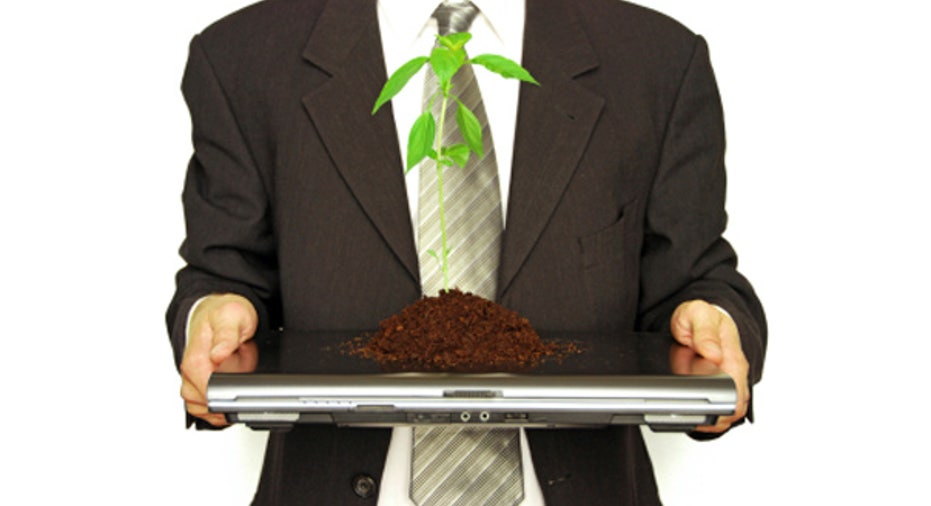Easy Ways Workers Can Green the Office

While big environmental changes often come from the head office, employees have a lot more control over the greening of their workplace than they may think. That's the word from NSF International, the organization that sets safety and health standards for food, water and consumer goods.
According to the NSF, there are lots of things you can do without any help from your boss that will make your office a greener and healthier place.
- Green you’re air: Plants do more than just pretty up your work space. Plants also absorb indoor air pollution and increase the flow of oxygen and can help prevent "Sick Building Syndrome" — a condition where off-gassing office decor, carpeting and furniture can lead to upper-respiratory colds, eye infections and viruses and inflame allergies.
[The Lone Ranger and Four Other People Everyone Wants to Hire]
- Use green cleaning supplies: When cleaning your desk, choose products that are certified for "green cleaning." These products will be hard on germs, but easy on the environment.
- Drink smart: The Natural Resource Defense Council suggests coffee itself is less sustainable than the coffee pot. Look for coffee that is organic, shade grown and fair traded. Using stainless steel filters rather than paper filters, unplugging the pot when not in use and bringing reusable mugs and glasses to work is also important.
- Bring your lunch: Bringing lunch to work in reusable containers is more sustainable for the environment and for your wallet — it also encourages healthier eating. If your workplace has a cafeteria, encourage employees to use washable trays, serving dishes and utensils rather than disposable containers or plastic utensils. When you do choose to order food, try to do so with a group to minimize the trash, tell the vendor to forgo the plastic utensils and paper plates and if the vendor is offsite, consider walking to the location to pick up your order rather than having it delivered.
- Don’t be a paper pusher: The Sierra Club estimates that the average U.S. office worker goes through 10,000 sheets of copy paper a year. Instead of printing out copies of important documents or agendas for meetings, save those documents on a shared drive and pull them up for everyone to view collectively in the meeting.
- Revamp your to-do list: For those who prefer to write out daily lists and cross items off as completed, consider making this method more sustainable to avoid pushing so much paper. You can digitize your to-dos on a smartphone or computer or invest in a dry-erase board, which allows you to continue writing yourself notes and lists without harming trees. You can even purchase refillable dry-erase markers.
- Reduce over reuse: Office paper is highly recyclable, but a lot gets wasted. Waste reduction is often more cost-effective than recycling because it reduces the amount of material that needs to be collected, transported and processed. That said, recycled paper is still friendlier than new — in fact, 55 percent of water is saved by producing recycled paper compared with virgin paper and recycled paper uses 60-70 percent less energy to produce than paper from virgin pulp. Recycled copier paper is usually more opaque than paper made from virgin materials, making it easier to print on both sides and not get "show through" printing on the opposite side.
- Adjust your print settings:Color printing generally uses more ink, so print in black and white when you can or to conserve even more ink, print in draft mode. Also, try reducing your margin settings (wider margins, smaller font size) to fit more text on a single page — your printer will use less paper. Print duplex or double-sided whenever possible. Set duplex printing as the default and change it on an individual print basis only when you have to.
- Use paper clips instead of staples: Paper clips are sustainable by design. When made of the traditional plain aluminum, they are readily recyclable and can be reused. Make sure to recycle your paper clips when you have exhausted their use and reuse them if people leave them in meetings.
- Forget the screen saver: Removing your screen saver is a simple way to be sustainable. Screen savers use excess energy when you are away from your desk. Change your screen settings to "hibernate" or "sleep" when you're away from your computer for more than 10 minutes.
- Avoid hidden power usage: Many devices have "standby" settings that draw power — sometimes as much as 15 or 20 watts — even when they're turned off. To make sure that your computer, monitor, printer, photocopy machine, television, etc. are all the way off, pull the plug rather than flipping the switch before heading out the door. To make it easier, try plugging hardware into a power strip with an on/off switch (or a smart power strip), the whole desktop setup can be turned off at once.
- Turn off task lighting or overhead lights when you leave your office for meetings. Energy-saving is important, but the benefit gained from establishing a good habit and the message it sends to conserve when possible, is even more important.
- Employees' Most Outrageous 'Late' Excuses
- 10 Personality Types Most Likely to Get Hired
- The 10 Craziest Environmental Ideas
Copyright 2012 BusinessNewsDaily, a TechMediaNetwork company. All rights reserved. This material may not be published, broadcast, rewritten or redistributed.